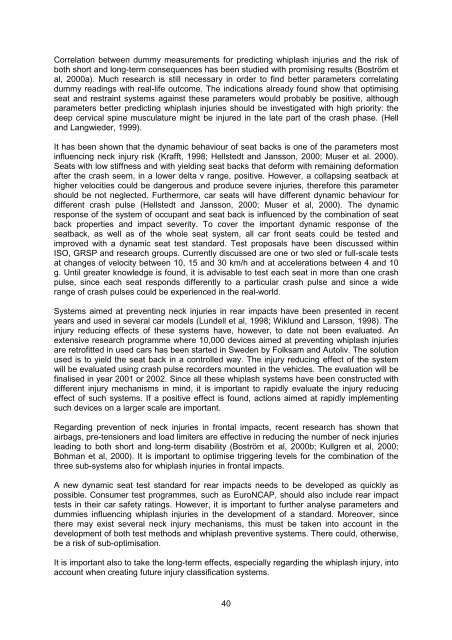PRIORITIES FOR EU MOTOR VEHICLE SAFETY DESIGN
priorities for eu motor vehicle safety design - ETSC
priorities for eu motor vehicle safety design - ETSC
You also want an ePaper? Increase the reach of your titles
YUMPU automatically turns print PDFs into web optimized ePapers that Google loves.
Correlation between dummy measurements for predicting whiplash injuries and the risk of<br />
both short and long-term consequences has been studied with promising results (Boström et<br />
al, 2000a). Much research is still necessary in order to find better parameters correlating<br />
dummy readings with real-life outcome. The indications already found show that optimising<br />
seat and restraint systems against these parameters would probably be positive, although<br />
parameters better predicting whiplash injuries should be investigated with high priority: the<br />
deep cervical spine musculature might be injured in the late part of the crash phase. (Hell<br />
and Langwieder, 1999).<br />
It has been shown that the dynamic behaviour of seat backs is one of the parameters most<br />
influencing neck injury risk (Krafft, 1998; Hellstedt and Jansson, 2000; Muser et al. 2000).<br />
Seats with low stiffness and with yielding seat backs that deform with remaining deformation<br />
after the crash seem, in a lower delta v range, positive. However, a collapsing seatback at<br />
higher velocities could be dangerous and produce severe injuries, therefore this parameter<br />
should be not neglected. Furthermore, car seats will have different dynamic behaviour for<br />
different crash pulse (Hellstedt and Jansson, 2000; Muser et al, 2000). The dynamic<br />
response of the system of occupant and seat back is influenced by the combination of seat<br />
back properties and impact severity. To cover the important dynamic response of the<br />
seatback, as well as of the whole seat system, all car front seats could be tested and<br />
improved with a dynamic seat test standard. Test proposals have been discussed within<br />
ISO, GRSP and research groups. Currently discussed are one or two sled or full-scale tests<br />
at changes of velocity between 10, 15 and 30 km/h and at accelerations between 4 and 10<br />
g. Until greater knowledge is found, it is advisable to test each seat in more than one crash<br />
pulse, since each seat responds differently to a particular crash pulse and since a wide<br />
range of crash pulses could be experienced in the real-world.<br />
Systems aimed at preventing neck injuries in rear impacts have been presented in recent<br />
years and used in several car models (Lundell et al, 1998; Wiklund and Larsson, 1998). The<br />
injury reducing effects of these systems have, however, to date not been evaluated. An<br />
extensive research programme where 10,000 devices aimed at preventing whiplash injuries<br />
are retrofitted in used cars has been started in Sweden by Folksam and Autoliv. The solution<br />
used is to yield the seat back in a controlled way. The injury reducing effect of the system<br />
will be evaluated using crash pulse recorders mounted in the vehicles. The evaluation will be<br />
finalised in year 2001 or 2002. Since all these whiplash systems have been constructed with<br />
different injury mechanisms in mind, it is important to rapidly evaluate the injury reducing<br />
effect of such systems. If a positive effect is found, actions aimed at rapidly implementing<br />
such devices on a larger scale are important.<br />
Regarding prevention of neck injuries in frontal impacts, recent research has shown that<br />
airbags, pre-tensioners and load limiters are effective in reducing the number of neck injuries<br />
leading to both short and long-term disability (Boström et al, 2000b; Kullgren et al, 2000;<br />
Bohman et al, 2000). It is important to optimise triggering levels for the combination of the<br />
three sub-systems also for whiplash injuries in frontal impacts.<br />
A new dynamic seat test standard for rear impacts needs to be developed as quickly as<br />
possible. Consumer test programmes, such as EuroNCAP, should also include rear impact<br />
tests in their car safety ratings. However, it is important to further analyse parameters and<br />
dummies influencing whiplash injuries in the development of a standard. Moreover, since<br />
there may exist several neck injury mechanisms, this must be taken into account in the<br />
development of both test methods and whiplash preventive systems. There could, otherwise,<br />
be a risk of sub-optimisation.<br />
It is important also to take the long-term effects, especially regarding the whiplash injury, into<br />
account when creating future injury classification systems.<br />
40



